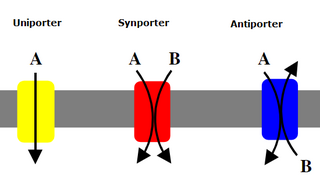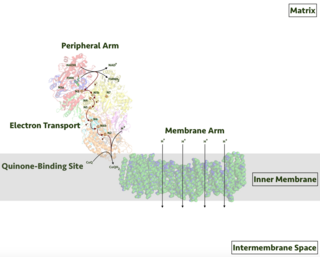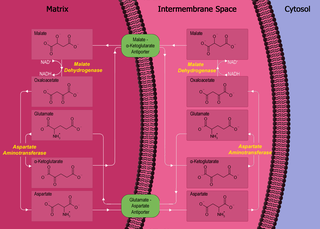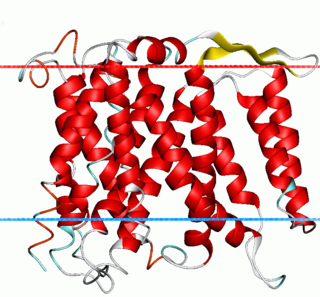The Na+ Transporting Mrp Superfamily is a superfamily of integral membrane transport proteins.
A protein superfamily is the largest grouping (clade) of proteins for which common ancestry can be inferred. Usually this common ancestry is inferred from structural alignment and mechanistic similarity, even if no sequence similarity is evident. Sequence homology can then be deduced even if not apparent. Superfamilies typically contain several protein families which show sequence similarity within each family. The term protein clan is commonly used for protease and glycosyl hydrolases superfamilies based on the MEROPS and CAZy classification systems.
A membrane transport protein is a membrane protein involved in the movement of ions, small molecules, or macromolecules, such as another protein, across a biological membrane. Transport proteins are integral transmembrane proteins; that is they exist permanently within and span the membrane across which they transport substances. The proteins may assist in the movement of substances by facilitated diffusion or active transport. The two main types of proteins involved in such transport are broadly categorized as either channels or carriers. The solute carriers and atypical SLCs are secondary active or facilitative transporters in humans.
It includes the TC families:
2.A.63 - The Monovalent Cation (K+ or Na+):Proton Antiporter-3 (CPA3) Family
The Monovalent Cation (K+ or Na+):Proton Antiporter-3 (CPA3) Family (TC# 2.A.63) is a member of the Na+ transporting Mrp superfamily. The CPA3 family consists of bacterial multicomponent K+:H+ and Na+:H+ antiporters. The best characterized systems are the PhaABCDEFG system of Sinorhizobium meliloti (TC# 2.A.63.1.1) that functions in pH adaptation and as a K+ efflux system, and the MnhABCDEFG system of Staphylococcus aureus (TC# 2.A.63.1.3) that functions as a Na+ efflux Na+:H+ antiporter.
3.D.1 - The H+ or Na+-translocating NADH Dehyrogenase (NDH) Family
3.D.9 - The H+-translocating F420H2 Dehydrogenase (F420H2DH) Family
The H+-translocating F420H2 Dehydrogenase (F420H2DH) Family(TC# 3.D.9) is a member of the Na+ transporting Mrp superfamily. A single F420H2 dehydrogenase (also referred to as F420H2:quinol oxidoreductase) from the methanogenic archaeon, Methanosarcina mazei Gö1, has been shown to be a redox driven proton pump. The F420H2DH of M. mazei has a molecular size of about 120 kDa and contains Fe-S clusters and FAD. A similar five-subunit enzyme has been isolated from Methanolobus tindarius. The sulfate-reducing Archaeoglobus fulgidus (and several other archaea) also have this enzyme.
Mrp of Bacillus subtilis is a 7 subunit Na+/H+ antiporter complex (TC# 2.A.63.1.4). All subunits are homologous to the subunits in other members of this monovalent cation (K+ or Na+):proton antiporter-3 (CPA3) family as well as subunits in the archaeal hydrogenases (TC#s 3.D.1.4.1 and 3.D.1.4.2), which share several subunits with NADH dehydrogenase subunits (3.D.1). The largest subunits of the Mrp complex (MrpA and MrpD) are homologous to subunits in NADH dehydrogenases (NDHs): ND2, ND4 and ND5 in the fungal NADH dehydrogenase complex and most other NDHs, as well as subunits in the F420H2 dehydrogenase of Methanosarcina mazei (TC#3.D.9.1.1). [1] These homologous subunits may catalyze Na+/K+ and/or H+ transport.

Bacillus subtilis, known also as the hay bacillus or grass bacillus, is a Gram-positive, catalase-positive bacterium, found in soil and the gastrointestinal tract of ruminants and humans. A member of the genus Bacillus, B. subtilis is rod-shaped, and can form a tough, protective endospore, allowing it to tolerate extreme environmental conditions. B. subtilis has historically been classified as an obligate aerobe, though evidence exists that it is a facultative anaerobe. B. subtilis is considered the best studied Gram-positive bacterium and a model organism to study bacterial chromosome replication and cell differentiation. It is one of the bacterial champions in secreted enzyme production and used on an industrial scale by biotechnology companies.

An antiporter (also called exchanger or counter-transporter) is a cotransporter and integral membrane protein involved in secondary active transport of two or more different molecules or ions across a phospholipid membrane such as the plasma membrane in opposite directions. Na+/H+ antiporters have been reviewed.





